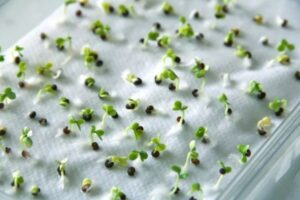Growing vegetables like carrots and parsnips in toilet paper rolls may sound unconventional, but it’s an innovative technique that has proven successful for many gardeners. This method not only saves space but also helps protect seedlings from damage and promotes healthier root development.
Why Toilet Paper Rolls?
Toilet paper rolls—often referred to as loo rolls—are a fantastic, eco-friendly way to start your seeds. These small cardboard tubes are easy to find, inexpensive, and can be reused in creative ways to benefit your garden. The method of growing carrots, parsnips, and other vegetables in toilet paper rolls is not new; it dates back several years. In fact, English gardeners first discovered that using tubes could help them grow perfect parsnips by protecting the delicate taproot from disturbance during transplantation. More recently, American gardeners have embraced this technique to protect young carrots from cutworms, which often damage seedlings by severing them at the soil line.

Setting Up Your Seed Starting Station
To begin, gather a few empty toilet paper rolls and a container with good visibility, such as a clear plastic salad box. Write down the name of the plant you’re growing on each tube, so you can easily identify them. Arrange the tubes inside the container, leaving slight gaps between each one to allow air circulation. You can also fold the tubes into squares to help them stay upright, though the circular shape provides more uniform growing conditions.
Fill each roll halfway with a good quality seed-starting mix or potting soil, and gently tamp it down to eliminate air pockets. After filling the tubes, tamp the soil again to ensure it’s compacted. Don’t worry if some soil spills around the edges—it helps protect the tube from drying out. Moisten the soil until the outside of the tubes is damp.
Priming Your Seeds for Faster Germination
Carrot and parsnip seeds germinate more quickly when they’re prepped before planting. To do this, soak the seeds overnight in water, then dry them on a paper towel. Alternatively, you can prime them by keeping the seeds wrapped in damp paper towels for a few days before planting. Once primed, plant three seeds per tube and thin them down to the healthiest seedling once they begin to sprout.

Watering and Moisture Control
Proper moisture is essential for seedling success. Keep an eye on the soil, ensuring it’s neither too wet nor too dry. Water gently from the top, and monitor the moisture level by checking the color of the cardboard tube. If the soil dries out, use a spray bottle to moisten the outside of the tube. Be cautious of overwatering, as excessive moisture can lead to mold growth on the cardboard.
Transplanting Seedlings
Carrots and parsnips grow quickly, especially their taproots. Transplant seedlings as soon as they show their first true leaf. This is important because if the taproot grows too large, it can become constrained by the tube. To transplant, carefully lift the seedlings from the tube with a spatula and place them in a well-prepared garden bed. Leave the top of the tube exposed above the soil—this acts as a barrier against cutworms and may help deter slugs. The cardboard will eventually break down and rot in the soil, leaving only the top portion behind.

The Benefits of Using Toilet Paper Rolls
One significant benefit of this method is that it minimizes root disturbance during transplantation. In my own experience, I found that the carrots grew straight, with no forked or misshapen roots. The color of the roots was also vibrant. As the tubes break down in the soil, they provide additional organic material, improving the quality of the soil.
Other Garden Uses for Toilet Paper Rolls
Toilet paper rolls aren’t just great for carrots and parsnips—they also work well for other plants with deep taproots, such as snap beans and sweet corn. They can also be used for plants like sweet peas, which are sensitive to root disturbances. In addition, you can use toilet paper rolls to protect the necks of leeks as they grow, preventing soil from accumulating around the stem. Once you’ve exhausted their use in the garden, toilet paper rolls can be added to your compost bin to help balance moisture levels and provide habitat for beneficial composting organisms.
Conclusion
Using toilet paper rolls to grow carrots, parsnips, and other vegetables is a simple and effective way to protect your seedlings, encourage strong root growth, and even deter pests like cutworms. It’s an easy method that not only saves you money but also helps reduce waste. Whether you’re an experienced gardener or just starting out, this technique is worth trying for a more successful and sustainable gardening season.
